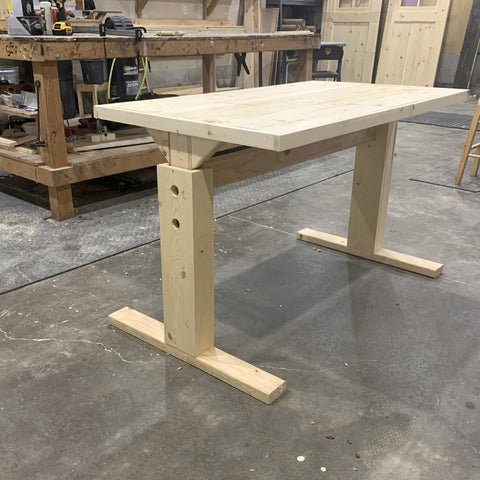sales@tecnotools.com.au
sales@tecnotools.com.au
Call us: 0433 734 100

Some people use DIY as a healthy way to escape from the stress of every-day life. They tap into creativity they did not even know they possessed. Besides, there is an incredible rewarding feeling of finishing a project without hiring a professional to get the job done.
Following the same ascendance trend of DIY we have sit-stand desks. These adjustable height desks are becoming increasingly popular in office workplaces and even some schools. Research into these desks claim a whole deal of benefits with their use. It gives you the freedom to switch between sitting and standing by changing the position of your desk. An ergonomic adjustable standing desk can help to eliminate the discomfort that occurs from sitting down in one position for too long, as well as helping to boost productivity and activity levels.

In order to fully benefit from your sit-stand desk, it is important to customize your workspace to suit your body’s needs. Using standing desks correctly may seem like a no-brainer from an outsider’s perspective: You stand. You work. You repeat. However, ergonomics is not an exact science because every human body is different. The optimal height for your desk will be different for you than for someone else.
The main misconception towards sit-stand desks is that people assume that you are supposed to be standing all the time while using them, where in fact, you are not supposed to. The key to benefit the most of a sit-stand desk is to vary between sitting and standing throughout the day. Besides, there is a correct height for your keyboard, the monitor must be positioned to optimize your posture, and there is a specific length of time you should be standing or sitting. In other words, the sit-stand desk must be fine tuned so it can work properly; and that is why a home-made desk can easily fail to achieve its main goal: making your workday more comfortable, improving your productivity and reduce health issue associated to bad ergonomics habits.
If you search on the internet for the term “How to Make Sit Stand Desk” undoubtedly you will find many different projects to follow and try yourself. However, not many of them, if any, will emphasize the necessary fine tune capability to achieve ergonomics level of customization.
Common Problems with DIY Sit-Stand Desk
Material of construction: When you think about DIY, I am sure the first material that comes to your mind is wood. It is highly customizable, relatively easy to use, there are many tools and equipment widely available on the market for woodwork projects. For all these reasons, the vast majority of DIY sit stand desk projects are made almost entirely with wood. However, there is one main issue with wood, the tensile strength tends diminish with time. It means your DIY sit stand desk will probably lose its alignment at some point in time.

It is difficult to adjust: As I mentioned before in this article, fine tuning a sit stand desk is extremely important so it can be efficient. Creating a DIY adjustable standing desk is not as easy as it sounds. For the most part, the DIY projects that I have seen that have adjustment are very cumbersome. Consider you have a desk full of items like, monitors, computers, phone, etc. If your desk requires you to loosen or remove bolts, then physically move the desk, how likely are you to do that regularly?

Stability issues: All it takes for building an unstable desk is a few millimeters out. Due to the high number of parts you need to cut millimetric correct to finish your DIY site stand desk, the chances are some of them will be a little bit too short, or little bit too long. Table footings must be made of sturdy wood or steel to avoid stability issues. The problem with materials that can be easily bought from a hardware store is that these may be too heavy for the adjustment mechanisms that a DIY standing desk requires.

The cost: When planning to build a DIY sit stand desk, it is not only the cost of raw material. The tools you need to work the wood will certainly be way more expensive than a professionally made sit and stand desk. Considering you are a DIY hobbyist and have all the tools you need will save you a significant amount of money. However, you need to consider the time you will be to plan, design, source the material, build and finish your project. Always consider that a successful sit stand desk, it is not a desk that goes up and down. It needs to be highly adjustable and capable of being fine-tuned.

DIY sit stand desk frame: The frame is the part of the desk that needs most of the work. It is very easy to get something wrong while working on the footing, adjustments, alignment and etc. While the desktop is way easier to deal with, the frame is time consuming and will take most of the time you have dedicated to your project. If you end up having issues with your desk, it is likely it will be on the frame, so extra attention must be given to the part of your project.

How to make a DIY sit stand desk that is worth it?
Any desk is made of two basic components: a tabletop and a frame. A DIY sit stand desk frame, for all the reasons I have mentioned above can be very difficult to build. However, a tabletop can be easily worked to fit the frame. Professionally electric desk frames are sold for just a fraction of the cost of a electronic desk. This way, you have all the features you need in sit stand desk, and can still save money by getting a DIY tabletop. Besides, after the project is completed, the satisfactory of completion is the same.